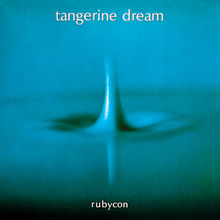Rubycon (album)
Rubycon is the sixth major release and sixth studio album by German electronic music group Tangerine Dream. It was released in 1975.[1] It is widely regarded as one of their best albums. Rubycon further develops the Berlin School sequencer-based sound they ushered in with the title track from Phaedra.
| Rubycon | ||||
|---|---|---|---|---|
 | ||||
| Studio album by | ||||
| Released | 21 March 1975 | |||
| Recorded | January 1975, The Manor, Shipton-on-Cherwell | |||
| Genre | ||||
| Length | 34:53 | |||
| Label | Virgin | |||
| Producer | Tangerine Dream | |||
| Tangerine Dream chronology | ||||
| ||||
| Audio sample | ||||
Rubycon: Part 1"
| ||||
Although not quite matching the sales figures for Phaedra, Rubycon reached number 10 in a 14-week run, their highest-charting album in the UK.[2]
Music
The album consists of two long tracks, each just over 17 minutes long. "Rubycon, Part One", the A-side of the LP, "ebbs and flows through tense washes of echo and Mellotron choirs, as primitive sequencer lines bubble to the surface”.[3] The B-side, "Rubycon, Part Two", "opens in a wonderfully haunted way" before "the synthesizer arpeggios return to drive things along".[3]
Critical reception
| Review scores | |
|---|---|
| Source | Rating |
| AllMusic | |
| Head Heritage | positive[4] |
Tom Moon includes Rubycon in his 2008 book 1,000 Recordings to Hear Before You Die, sayng: "This voyaging vision of sound, ever-unfolding and not quite ever arriving, has been imitated endlessly since 1975. But somehow its admirers haven’t quite captured the openness and faraway grandeur of Tangerine Dream."[5]
In his 1997 book Digital Gothic: A Critical Discography of Tangerine Dream, music journalist Paul Stump praises the album, noting: “Rubycon is simply a refinement of its predecessor—but to an acme of excellence, and demonstrates a mastery of primitive technology breathtaking in its audacity, tenacity and sheer artistic vision. It is probably the best album the band have made…” [6]
Tour
After the album was released, Christopher Franke's Moog synthesizer was damaged in transit during a tour and Franke himself was nearly killed by an electrical shock.[7]
Track listing
| No. | Title | Length |
|---|---|---|
| 1. | "Rubycon, Part One" | 17:18 |
| 2. | "Rubycon, Part Two" | 17:35 |
Personnel
- Edgar Froese - mellotron, guitar and VCS 3 synthesizer on "Rubycon, Part One" ; organ, mellotron, guitar, gong and VCS 3 synththesizer on "Rubycon, Part Two"
- Christopher Franke - double Moog synthesizer, Synthi A, organ, modified Elka organ and prepared piano on "Rubycon, Part One" ; double Moog synthesizer, gong, Synthi A, and organ on "Rubycon, Part Two"
- Peter Baumann - organ, EMS Synthi A, electric piano (Fender Rhodes) and prepared piano on "Rubycon, Part One" ; electric piano (Fender Rhodes), organ, EMS Synthi A, voice and ARP 2600 on "Rubycon, Part Two"
Production credits
- Monique Froese – photography
- Mick Glossop – engineer
- Roland Paulick – technical assistance
Single
A single titled Extracts From "Rubycon" was released in March 1975.[8]
| No. | Title | Length |
|---|---|---|
| 1. | "Extracts From "Rubycon"" | 3:07 |
| 2. | "Extracts From "Rubycon"" | 3:09 |
Both tracks of this single were included as part of the compilation The Virgin Years 1974–1978 in 2011.
References
- Berling, Michael (29 September 2016). "Rubycon". Voices in the Net.
- "Tangerine Dream". Official Charts.
- Swan, Glenn. Rubycon at AllMusic
- "Julian Cope Presents Head Heritage | Unsung | Reviews | Tangerine Dream – Rubycon". February 2010.
- Moon, Tom (2008). 1,000 Recordings to Hear Before You Die: A Listener’s Life List. New York: Workman Publishing Company. p. 762. ISBN 076113963X.
- Stump, Paul (1997). Digital Gothic: A Critical Discography of Tangerine Dream. Trowbridge: SAF Publishing Ltd. p. 67. ISBN 0946719187.
- Prendergast, Mark (1994). "Tangerine Dream: Changing Use of Technology, Part 1: 1967-1977". Sound On Sound.
- Berling, Michael (29 September 2016). "Extracts From "Rubycon"". Voices in the Net.
External Links
- Rubycon (album) at Discogs (list of releases)